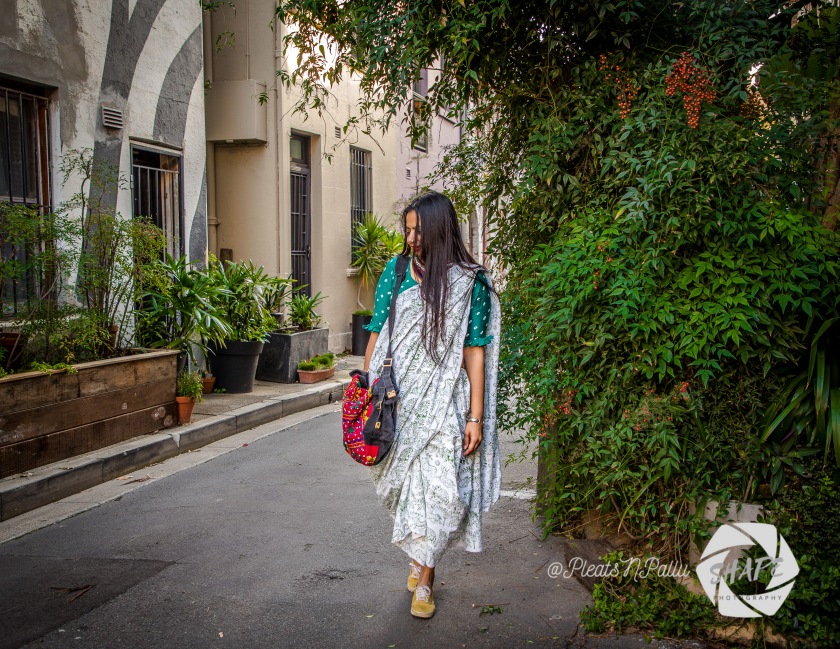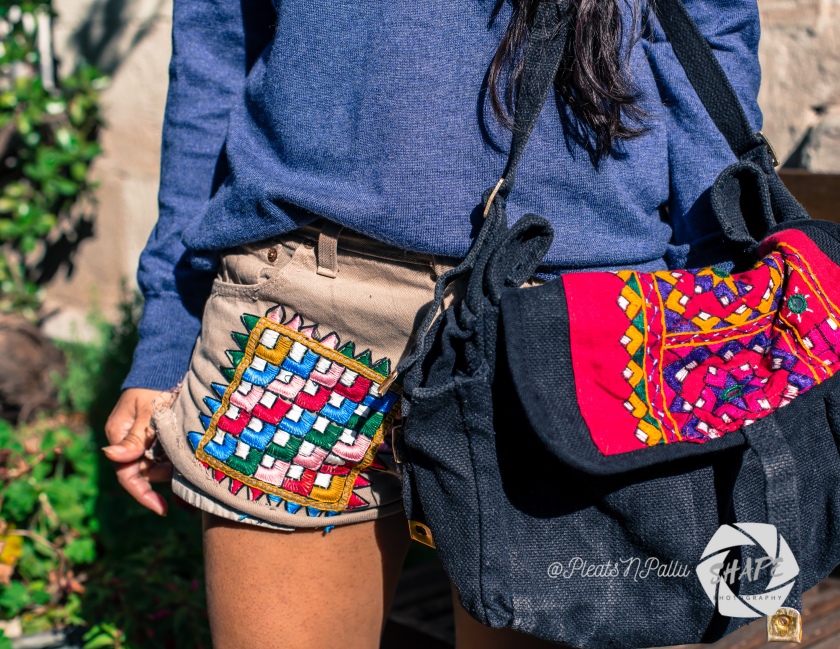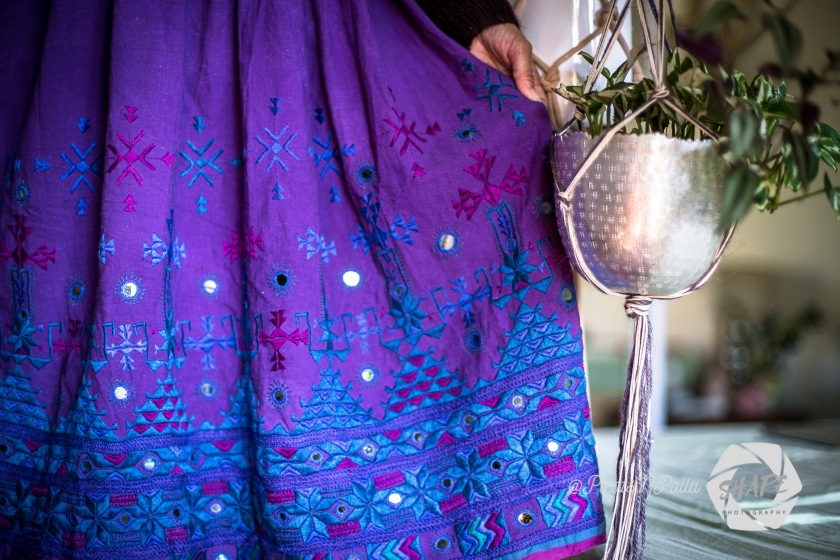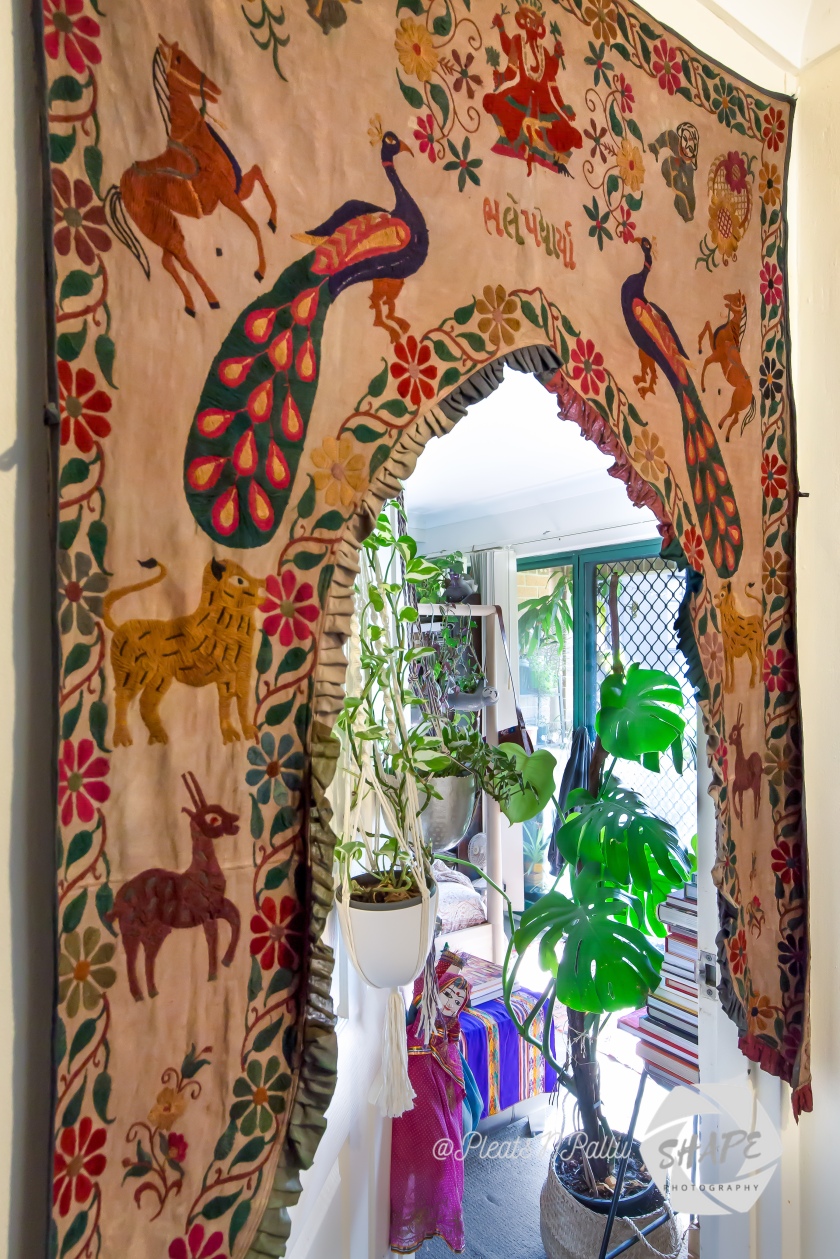Sewing colourful designs on fabric has been a defining tradition in parts of Gujarat predominantly Kutch (also spelled Kachchh) and Saurashtra as well as in the province of Sindh in Pakistan which borders Gujarat. The motifs and designs used in different styles of embroidery from this region are traditional markers of tribe and ethnicity.




Photos: Vincent Boyer (Say hi on instagram @shape.photos)
Embroidered textiles across the world weave a tale of identity, culture and folk lore in their patterns and motifs. The above photos feature various textiles that have been embroidered by artisans in Gujarat, India as well as by me in the traditional styles of embroidery indigenous to the region.
Communitities residing in Kutch, Sindh and Saurashtra produce costumes for themselves as well as their animals plus many more personal, household, dowry and festive items and textiles, incorporating the elements of needle craft and bead work prominently using cowrie shells and mirrors.
Spending a bulk of my formative years with easy access to artisans who were adept at these craft forms has resulted in me becoming massively obsessed with collecting these textiles and learning embroidery.
I am going to share a little snippet of my collection from the region as well as my own creations in a series of blog posts discussing the needle work heritage of the area.
The first photo features a hand block print yardage in the gamthi style from Gujarat worn as a saree with an ‘ek dana’ Jamnagari bandhani blouse and a black army surplus bag featuring a Neran style hand embroidered patch. The second photo features the same style of embroidery on the bag as well as a pair of vintage Levis 501 cut-offs that I have had for years.
I embroidered and attached the red patch on the bag about seven years ago, it was featured in my other blog here and here. This period of self-isolation has resulted in me beginning a slew of needlework projects including the denim shorts.
The third photo features a vintage embroidered skirt in the Suf style and the fourth an elaborate toran (door hanging) from Saurashtra.
I am incredibly drawn to the colours and motifs of the intricate styles in Kutch and Saurashtra. Because of the ancient tradition of trade and migration from Central Asia within the pastoral and herding communities that practice these crafts, it is difficult to pinpoint the exact home territories for these art forms. But it is apparent for anyone to sees, the design language of many styles of needle work across Central and South Asia have similar origins.
In the content below I am going to try and share some interesting details about the various embroidery styles showcased in the photos above.
Kutch: The name may have been derived from the word ‘kachho’ which means turtle or tortoise because the shape of the area resembles a shell of one. The word is also said to mean that which is intermittently wet and dry because a large part of the area is shallow wetland which gets waterlogged during the rainy season and dries out during the rest of the year.
Overall I know of eight distinct styles of embroidery in Kutch that have differing interplay of stitches, mirrors, motifs, borders and style.
There is a commonality of dress amongst all of the communities residing in Kutch: a chaniyo/ ghagro (gathered skirt), kancholi (long backless blouse), kapada (short blouse) and odhni (long veil down) for women. The men traditionally wear a dhoti (a length of long fabric draped on the lower body), vanjani (gathered pants), kediyu (gathered short shirt), kameez (long shirt), bandi (short shirt), shawls, topis (caps) and turbans. However, specific differences in colours, fabric and ornamentation, designate each community, and within them age and marital status.
Neran: This style is showcased on the bag in photo one and two and the denim shorts in photo number two.
The term neran is derived from the word nen- which means eyes/eyebrow. If you look closely at the pair of shorts and the fabric bag, the smaller diamond in white denotes the eye, the surrounding curved design in brighter colours symbolises the brow. And the entire motif is always outlined by black thread.
This style of embroidery uses mirrors (abla or abhla) sparingly and is charaterised by the extensive use of the buttonhole stitch (locally called jat). This type of needle work is a hallmark of the Marwada Harijan community and was very popular a few decades ago.
Suf or soof: This style is showcased on the skirt in photo number four.
The intricate suf embroidery is a type of counted yarn embroidery that looks more like a weave than surface ornamentation, which is practiced continuously by the Sodha Rajput community since the thirteenth century.
The word suf literally means a triangle and this type of work is characterised by a heavy use of symmetrical geometric motifs that are exceptionally complex. It is counted on the warp and weft threads from the back and worked in satin stitch.
The design and the motifs aren’t pre-drawn onto the base fabric, the artisan envisions their plan as they go and counts it out in reverse while developing the pattern around a progression of triangles and diamonds.
More often than not tiny fragments of mirrors (abla or abhla) are incorporated into the intricate pattern. This type of work was generally used to embellish a bride’s collection of apparel included as part of her family’s gifts to the bridegroom’s family.
The skirt I am wearing in the photo is a vintage piece featuring elaborate suf motifs that I treasure and have been wearing for close to two decades. This style is also practiced extensively in the Sindh region of Pakistan.
One day I hope to travel there to pick up some Sindhi Ajrakh and hand embroidered treasures in person.
Saurashtra: In Sanskrit, saura means sun, and rastra means worship – the region was named after its ancient sun worshiping Aryan inhabitants. It is the large central to southern peninsula of Gujarat which more recently is locally called Kathiawar or Kathiawad after the Kathi people.
Kathi or Kathipo: The vintage toran (door panel) in photo number four is a wonderful example of Kathi (also known as Kathipo) style of embroidery, which is used primarily on household articles. This type of needlework forms one of the most prominent and oldest among embroidery traditions in the region.
The name of this style of embroidery is derived from its practitioners, the Kathi people, who are a land owning community consisting of three clans: Wala, Kuhmn, and Khacharas. The kathi style has since been adopted by other groups, like the Gohilvadi Rabaris. Yes, there are plenty of Rabaris outside of Kutch.
This style features an elongated darning stitch (adiya-fatiya), chain stitch, and an interlacing stitch (desi bharat) used in conjunction with tiny pieces of mirrors and worked with silk floss (heer) onto a cotton surface. This toran depicts deities of baby Krishna and Ganesh and features the words Bhale Padharya (you’re welcome into this home). Both geometric and figurative imagery abound on these surfaces.
A Toran is deemed to be a protective and auspicious talisman for the inhabitants of the house as well as for the guests. I have a major obsession with collecting vintage hand embroidered and beaded torans from Kutch and Saurashtra.
Fun fact: The mirror work patterns that we see today traditionally didn’t use mirror or glass but tiny fragments of mica that were locally available or pieces of tin, silver or coins.
If you enjoyed reading this post and want to know more about embroidery styles of the region, I recommend the following books:
1. Catalog of Embroidered Textiles from Cutch and Kathiawar in the Indian Museum: Santipriya Mukhopadhyay
2. The Embroidery and Beadwork of Kutch and Saurashtra: J.M. Nanavati, M.P. Vora, and M.A. Dhaky
I have a few more books on my wish list that I will share in the upcoming blog posts, so keep an eye out for them.